Alex Li Trisoglio
Madhyamakavatara Week 2: Wisdom and Compassion

Week 2: Wisdom and Compassion
14 June 2017 / 118 minutes
Question: Why do we need to study and establish the view? Why can’t we just do our practice? What does progress on the path look like?
Reference: Madhyamakavatara verses 1:1 – 6:7
Transcript / Pre-reading / Audio / Video
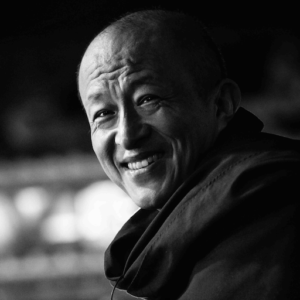
Overview of Week 2 [Audio/Video timing: t = 0:00:05]
Good evening everyone and welcome to Week 2. Most of what we’re going to do today is focus on the first five bhumis, and prepare for the adventure we’re going to embark on next week with Chapter 6. The focus of this week is understanding the relationship between view and bodhicitta or compassion, and especially the paramitas – the qualities such as generosity, patience and discipline that we seek to practice and cultivate on the path.
The Hero’s Journey [t = 0:00:44]
I’d like to start by setting the context, almost reframing these teachings as an adventure story, which may seem a little curious. But if you look at the 10 Bulls, the 10 Ox-Herding Pictures that we started talking about last week, the unfolding of those ten stages actually follows the same mythic structure as Joseph Campbell’s ‘Hero’s Journey’. In fact, so does the Buddha’s life story, the classic story. And for those of you who like movies, the most classic example might well be the original Star Wars movie, where George Lucas actually consulted with Campbell to structure the movie around these different phases of the Hero’s Journey.
The Hero’s Journey follows a classic three-act structure like the ancient Greek plays.
• Act I: is exposition or situation, the ordinary world where we start. And then something happens. There’s some kind of problem to solve, some kind of call to action. For us that would be starting in our ordinary samsaric life and then discovering the Dharma path, discovering the possibility of understanding nonduality and emptiness, and attaining enlightenment.
• Act II: And then at some point the Hero or Heroine decides to embark upon this path, which brings us to Act II, which is all around attempts to solve the problems that were set up in Act I. Most of the time this takes place in a strange and unfamiliar world. It’s not the ordinary world. It’s some kind of mythic world.
• Act III: Finally in Act III we have the resolution, where the Hero or Heroine comes back to the ordinary world bearing some kind of gift or elixir or new power, something that will bring benefit to the world.
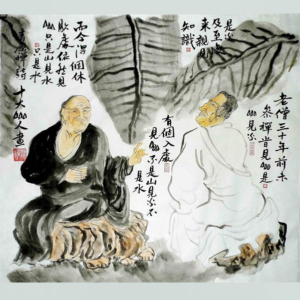
Setting off on the adventure [t = 0:02:52]
This is very much what the progression of the 10 Bulls looks like, if you follow that set of images and poems. And it’s also related to classic Zen story of Mountain / No Mountain / Mountain, which is a famous saying of ➜Ch’ing-yüan Wei-hsin (青原惟信, Japanese: Seigen Ishin), who was a 9th century Chan master of the Tang Dynasty. He said:
Before I had studied Zen for thirty years, I saw mountains as mountains, and waters as waters. When I arrived at a more intimate knowledge, I came to the point where I saw that mountains are not mountains, and waters are not waters. But now that I have got its very substance I am at rest. Once again I see mountains as mountains, and waters as waters.
So this idea of some kind of cyclical journey, where we start out seeing the world a certain way, we go on some kind of journey, and then we come back to our original world but now we see it in a new way. That’s very much what we’re doing here. This kind of understanding is at the heart of the Two Truths, and teachings like the Heart Sutra “form is emptiness, emptiness is form” although we won’t really get to those until Weeks 5 and 6. I just wanted to set us up.
And back to where we are right now: we’re still in Act I, and we’re actually in Scene 2.
• Act I, Scene 1: was the call to adventure, which we saw in Week 1. Realizing that view is important, and that it is worthwhile for us to cultivate the view.
• Act I, Scene 2: now the Hero really starts to question whether he wants to go on this journey. It could be a question of he has other duties, other obligations. Maybe he’s too busy, not enough time. It could be that he sees it as too challenging, too difficult, too academic, unrelated to his everyday concerns. Or maybe he feels that he already has some kind of path. Maybe we already feel we are practicing mindfulness or bodhicitta or whatever practice we might have. Maybe we feel we don’t need to take on this view of emptiness, because we already have what we need. And for those of you who are following the Forum discussion, there’s an interesting conversation about using emotions or emotionality as a path, which I think might be related to this.
Nevertheless, we still hear the call to adventure. Do we wish to embark upon the Middle Way? Do we wish to take our practice to the next level? That’s something that we can reflect upon. Are we ready to do that? And we might see perhaps that there is some resistance internally. We may find this a little challenging or difficult, or think we don’t want to do it. But that’s back to Campbell’s original structure. That’s a natural part of the Hero or Heroine’s Journey, and at some point we have to confront and overcome that resistance, so that we can truly embark upon the path. In this case, we’re going to start in Week 3 very much diving into the view, diving into the analysis, diving into this strange other world where we no longer see the mountain as a mountain, but instead start to decompose it and break it down. We’ll be doing a lot of that starting next week.
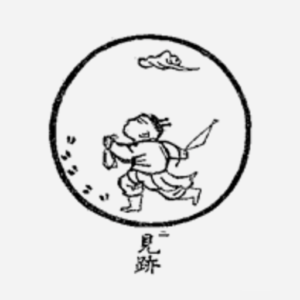
How will I perceive the true from the untrue? [t = 0:06:38]
So as I did last week, I’d like to read the relevant verse from the 10 Bulls. This is the second bull:
2. Discovering the Footprints
Along the riverbank under the trees, I discover footprints!
Even under the fragrant grass I see his prints.
Deep in remote mountains they are found.
These traces no more can be hidden than one’s nose, looking heavenward.
Comment: Understanding the teaching, I see the footprints of the bull. Then I learn that, just as many utensils are made from one metal, so too are myriad entities made of the fabric of self. Unless I discriminate, how will I perceive the true from the untrue? Not yet having entered the gate, nevertheless I have discerned the path.
I think that phrase, the idea of “how will I perceive the true from the untrue?”, is a very valuable question for us, especially when it comes to our practice. And that’s really a lot of what we’re going to talk about today. How should we practice? What kind of guidance do we have? How does the view inform our practice? We’re going to come back to this in Weeks 7 and 8, but this is a set up which will hopefully build the case for us to say that it is important for us to understand and establish the view so that we can then practice.

Crossing the river [t = 0:08:12]
I’d like to return to the notion of how view informs action. Last week we talked about the Buddha’s analogy of the path being like a raft, that should be for crossing over and not getting hold of. Obviously if we cross a river with our raft, we don’t want to carry the raft on our back once we have crossed over to the other side. We leave it by the river bank. We don’t take it with us. So let’s now imagine the Buddha teaching at Deer Park in Sarnath. Let’s imagine he wants to visit the river. Now as you may know, Sarnath is just a few miles away from present day Varanasi, which is on the banks of India’s holy river, the Ganges or Mother Ganga as she is known. Actually Varanasi is the oldest continually inhabited city in the whole of Asia, one of the ➜oldest cities in the world. It has been continually inhabited since 1800 BCE, and it grew as an important industrial centre, famous for silk fabrics, perfumes, ivory and sculpture. During the time of the Buddha, Varanasi was the capital of the kingdom of Kashi, extending along the western bank of the Ganges.
And if you visit Varanasi today, it’s pretty much the same. The holy city is very much on the western bank and if you look across the river to the eastern bank, there’s really not so much there right now except the sands of the floodplains where some ➜aghori sadhus live. But nevertheless, let’s imagine you wanted to cross the river, perhaps to meet some of these sadhus. So you go down to one of the ghats, you can see the far side maybe a quarter of a mile away from you, and you go to find a boatman to row you across in his raft. And you can still do this today. In Varanasi, many of the small boats are powered by humans rather than by diesel engines. There are a lot of boatmen there. So you get in the boat and you pull away, and within no time at all you’ll realise that the currents of the Ganges at Varanasi are very strong, and immediately you’ll start to be pulled downstream.
And of course if you just keep going in a straight line across the river, you’re going to end up far from your destination, because you’re going to be pulled miles away down the other shore. Now of course the boatmen know this. They’ve done this before, so they can correct for the current. They point their boat facing much upstream, and they row hard against the current and with this strange crab-like motion they actually end up crossing the river and perfectly reaching the destination. So you might say, in a way despite the obstacles of their path – in this case the strong currents of the river – they are nevertheless able to get to their goal because they have a clear view. Now in this case it’s literally a clear view, because they can see the other side. I hope you can see the analogy for our practice.

Choosing a boatman [t = 0:11:40]
There’s another lesson from this, which is: let’s imagine we do want to get to the other side, how should we choose a boatman? Would we focus on his appearance? Or perhaps how beautifully decorated his boat might be? These are visible, tangible things. But upon reflection we start to realize actually, no, the thing we really need in our boatman is the ability to have this clarity of view, to know how to navigate the currents. Because unless he does that, we’re never going to make it to our destination, no matter how attractive the boat might be. And when Dzongsar Khyentse Rinpoche taught Madhyamaka in France in 1996, he opened the teachings very much this same way, and it’s very relevant for us. He said (see page 1 in the transcript):
“Now that the period of Buddhism’s introduction in the West is almost over, we need to establish the proper study and practice of Buddhism. Up to now, we have tended to emphasize the methods, things like meditation and gurus, but we have tended to forget the view. The study of Madhyamaka is important because it has vast and intensive analyses and methods to establish the view. Having the right view is like knowing the direction to Paris. Suppose that you are travelling to Paris with a guide who says that he knows the road, and then suddenly your guide takes out a guidebook and starts to act a little strangely. If you know the direction to Paris, then whether the guide is leading you along the highway or through the bush does not matter. As long as he is heading in the right direction, it does not even matter if he acts nervously, because you know and trust the direction.
Nowadays, it seems that people do not care much about the direction, but instead the car inspires them – the Vajrayana vehicle, the Mahayana vehicle and so on. Even worse than that, they find inspiration in the guide. With this approach, unless you have so much merit that you accidentally find success, it is quite difficult to attain the result. We hear teachings like “rest in the nature of the mind”, which are very intoxicating and nice to hear, but we have no fundamental understanding of the view.”
Again I think this is a useful point of reflection for us as we consider our own relationship to the path, to the teachings, to our teacher. Are we actually focussed on the view? Are we focussed on knowing the direction? Or have we become perhaps a little too caught up in the vehicle itself, the path or indeed our teacher. These are important questions.

Distinguishing right and wrong paths [t = 0:14:27]
It’s one thing to be in Varanasi and to cross the river seeing the other bank, but what if you’re in a boat trying to cross the open ocean? You cannot see the other shore. You don’t know where you’re going. And without some kind of navigation, without some kind of guide or compass or way of knowing where you are and where you’re going, you will get lost. And I think that’s probably a more suitable analogy for most of us who are seeking to apply the teachings in our everyday lives in the world. The real question for many of us is: how should I act? It’s all very well to say that I have a view, but how can I apply this in my practice and in my daily life? And really the question is how can we then understand and apply the view of the Middle Way to help us answer this question of how should we act.
And it’s a paradox, because there really is a difference between the idea that the Buddha taught no view, and that the Buddha also taught that our path must be based on the right view. We’ll see this increasingly as we proceed through the text. Nagarjuna and Chandrakirti both say that the essence of the view is that there is no view. And yet the whole notion of a Noble Eight-Fold Path is that we distinguish the right path from the wrong path. It’s all around making sure that we know the difference between good and bad, and between right and wrong. If you look at these first five chapters and five bhumis, there’s a lot of discussion about the difference between good and bad. So we seem to have a paradox where at one level we very much have to discriminate between good and bad, right and wrong, what actually is the Noble Path. And then at another level, we have no view. So how are we supposed to understand these two? Rinpoche has taught about this, especially in the context of contemporary mindfulness teachings where, as you may know, there is a lot of emphasis on the idea that mindfulness should be non-judgmental. And yet if you look at the Buddhist teachings, there’s an essential element of judgment and discrimination. We need to distinguish right and wrong. We cannot just throw our hands up and say everything goes. So again, how to act?

Monastery rules [t = 0:16:59]
If you go back to the original Shravakayana path, it was primarily a monastic path, so action was very much in the context of the monastic life in a monastery. And famously there are the Pratimoksha vows, where literally prati means ‘towards’ and moksha means ‘liberation’, so the notion was that these vows laid out behaviours which would lead you to liberation. That all sounds very well, but I don’t know if you have ever looked at the ➜227 vows. I took a little look, and here are some of the 227 – and by the way, it’s obviously about life in a monastery, probably dealing with young boys, trying to teach them some kind of discipline. Some of the rules expressed in the vows include:
“You should eat a ratio of one part of curry to three parts of rice.”
“You should not hide curry under the rice in order to obtain more.”
“You should not slurp when you are drinking a liquid.”
These are clearly very specific and very relevant for monastic life, but one might ask how much can I really use these as general guidance for living a life in the world? Well, there are some of the Pratimoksha vows that apply to life in the world. For example, there is a set of vows about carpets:
“Not to accept carpets containing silk.”
“Not to accept the floor carpets only made of black sheep wool.”
“Not to accept a floor carpet that is, for more than half of it, made with black sheep wool and a quarter in white wool.”
“Not to purchase another floor carpet as long as the former is not six years old yet.”
Again these are very specific, and I guess if you’re in the carpet business they might be relevant, but for most of us, we listen to these things and it’s very hard to apply to our life in the contemporary world. And almost everything, if you look through the 227 vows, is about what you must not do. There’s very little about what is encouraged, what you should develop, what you should aspire towards as a good life in the world. And as Rinpoche has said, for most of us the notion of living in a monastery and practicing 24 hours a day, seven days a week, it’s not feasible. It’s not possible. We have lives. We have families. We don’t have the financial resources to devote ourselves to that.

Practical Dharma? [t = 0:19:55]
And even then, as a lot of modern Buddhism is now asking, if all we’re doing is sitting and meditating, and we’re not engaging in the world’s social and economic and environmental problems, are we really saying that Buddhism is relevant? In what way are we connected to the world? Hence you see the rise of so-called ‘engaged’ Buddhism, which is really saying we need to be much more engaged. Which by the way if you look at the origins of the Mahayana that grew out of the monastic tradition, a lot of it was because of the need to offer something to householders, who were not in monasteries. Until that point, really the only path for a householder was to make donations to the monastery, perhaps to make some aspirations that in a future rebirth you might be born as a monk, and then you could practice. There was very little you could do. And indeed as Rinpoche has also said, probably this disconnectedness from the everyday world is a big reason why Buddhism ended up disappearing in India and being displaced by Hinduism. It wasn’t seen as sufficiently practical. Perhaps the original populism was about giving people something that they want, but as Rinpoche says you can’t just give people what they want. You have to give them both what they want and what they need.
We need our Dharma to be something that helps transform us, helps us in our path to enlightenment and indeed that helps us to help others in that path, but it must still be somewhat practical. As we touched on last week, I think that is perhaps a good challenge for all of us as we think about our approach to the Dharma – how we seek to use it, to apply it, to practice it – are we becoming perhaps too practical?
To look again at contemporary mindfulness, so much of that nowadays has become how can we apply this in a corporate setting? What is the business case? How can mindfulness make people successful, happier, more productive? And it’s not that Buddhism is against these things, but at some point we have really lost the point of the path. We’re really just trying to make our samsara better rather than trying to understand how to uproot the root of samsara. And as you may know, Rinpoche was very concerned about this misapplication of Buddhist teachings and techniques, and that’s one of the reasons he titled his book Not For Happiness. It’s very easy to say yes of course if we practice Dharma we will, as a side effect, quite likely develop a happier outlook upon our life. But that’s not the purpose. We shouldn’t be approaching our Dharma as a means to make samsara better. Then we’ve completely lost the point.
And I suppose you can almost forgive people in the contemporary mindfulness movement, because when you look at the 227 vows you might easily say, “There’s not a lot of guidance there about how we should act.” And then when you look at the teachings on view, you hear that there is no view, and so for somebody who is not familiar with these teachings, it’s very easy to assume, “Well I guess they don’t have a lot to tell us then.” So you can understand why people might end up with a path that has just mindfulness divorced from any kind of ethic or any kind of right way to live, and also divorced from any kind of view.
ENTERING THE MIDDLE WAY
Which Madhyamaka is being introduced? [t = 0:24:00] [MAV PDF page 5]
That brings us then to the beginning of the Chandrakirti’s text, the Madhyamakavatara. He’s going to introduce the Madhyamaka – that’s the title of the text, Entering the Middle Way or Introduction to the Middle Way, and right at the beginning he says there are two kinds of Madhyamaka: which one are we going to be introducing? And he emphasizes that this text is all about introducing the ‘scriptural Madhyamaka’ not the ‘absolute Madhyamaka’. The scriptural Madhyamaka is the intellectual understanding, what we talked about last week as developing an Espoused Theory. But it’s not the same as what you will then realize once you practice based upon this Espoused Theory. That then is the realization of nonduality, which is the ‘absolute Madhyamaka’. That’s not something that we can introduce here, and as Rinpoche has said many times, listening to and studying the teachings can take us to a certain point, and then we have to practice. As we said last week, perhaps 98% of the path is practice. And teachings are always going to be in this domain of concepts, words, language, rationality – and we’re trying to get to a place that is beyond this dualistic world, beyond this rationality.
How is it introduced? [t = 0:25:29] [MAV PDF page 6]
So then Chandrakirti says, if we’re going to look at the scriptures, what are we going to look at? Are we looking at the sutras or are we looking at the shastras, the commentaries? And here Chandrakirti says we will be looking at the shastras, especially Nagarjuna’s famous commentary the Mulamadhyamakakarika. Part of the challenge for those of us reading this text in the contemporary world is that a lot of western Buddhism right now, especially in the Theravada tradition, is very focussed on authenticating teachings based on what is in the Pali suttas. Some of you may have read the pre-reading with Jay Garfield’s Buddhism in the West, and I think it’s a very important question: what do we consider the Buddha’s teaching? What is an authentic teaching? Is it just his earliest recorded words? Bear in mind that even those were four centuries after the Buddha taught. Or should we also include the people who followed in his lineage, and wrote later commentaries inspired by and following his teachings?
Because for example when Nagarjuna wrote and introduced the Madhyamaka, he wrote his commentary based on the sutras. We’ll come to that in a moment. But when he was writing around the end of the second century CE – that’s some six or seven centuries after the Buddha – by that stage there had been a lot of misinterpretation and misunderstanding of the original teachings. There had been a lot of misreadings. And so a big reason that he wrote the first Madhyamaka texts was to correct these misunderstandings and ensure an authentic interpretation of what the Buddha was trying to say. So you could say that a lot of what Nagarjuna was saying wasn’t in the original teachings of the Buddha. But the Buddha’s teachings alone were clearly open to more than one interpretation, and some people were interpreting the teachings in a way that in Nagarjuna’s opinion was incorrect.

A living tradition [t = 0:27:46]
My perspective on this is we can’t rely only on the Buddha’s words, because they did not take account of all the confusion that subsequent commentators introduced, which then needed to be removed or clarified. If we were that fundamentalist about our Buddhism, we would have a teaching that couldn’t adapt and respond to the contemporary interpretations and contemporary misunderstandings, and the needs of the modern world. And this is indeed the essence of a living tradition. On that note, until Pope Francis changed the official language of the Vatican in 2014, when he made the official language Italian, for the entire history of the Catholic Church it had always been Latin. So to ensure than Catholicism was a living tradition, because they spoke Latin at the meetings of the synod, they had to invent Latin words for cellphone and television and computer and things like that. If you’re interested by the way, the Latin word for ‘computer’ is computatrum. Of course that wasn’t in the original Latin, but that’s an example of where they had to introduce something to keep the teachings alive.
Now in the Buddhist tradition, a lot of the reason that a lot of the Abhidharma emerged and a lot of the subsequent commentaries on the teachings, is because the Buddha taught two things that seem quite paradoxical. He taught anatta, the idea that there is no truly existing self, but he also taught karma. He taught rebirth. And so the opponents of Buddhism in the early years of Buddhism in India were asking the Buddhists, “How can you explain this? How can you hold a view that says we have karma and rebirth, when you’re also saying there is no [truly existing] self? There is no [truly existing] self that is undergoing rebirth. There is no [truly existing self] that will receive the future consequences of one’s good or bad deeds today. If you insist there is no [truly existing] self, then the whole idea of karma and rebirth just collapses. In order to answer these objections, the early Buddhists came up with many theories, and those are what Nagarjuna sought to untangle and comment upon when writing the Mulamadhyamakakarika.
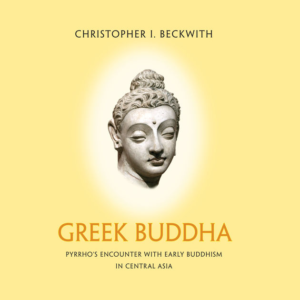
Greek Buddha [t = 0:30:28]
There’s something else that may potentially be of historical interest. I mentioned a moment ago that the first actual written version of the Buddha’s words was in Sri Lanka around the 1st century BCE, about 400 years after the Buddha died. And yes, Buddhism was an oral tradition that was memorized and handed down, but nevertheless this was 400 years later. And recently there has been some very interesting scholarship linking Buddhism with early Greek philosophy, specifically the skeptical philosophy of Pyrrho and his school. Because we know now that Alexander the Great travelled to Central Asia and to northwest India around 327-326 BCE, and the great philosopher Pyrrho of Elis travelled with him. And it has been suggested, and there’s quite good evidence for this actually – if you’re interested, I encourage you to read a book called Greek Buddha by Christopher Beckwith – that Pyrrho met and discussed philosophy with a lot of the Buddhist philosophers of the time. So now instead of the 1st century BCE this is the 4th century BCE, which is three centuries before the earliest recorded Buddhism that we have in the Pali Canon. We actually have some dated manuscripts from Pyrrho, which are authentically dated from 330-325 BCE. And it’s very interesting that if you read those texts of skeptical philosophy, Pyrrho bases his philosophy on three characteristics that are essentially the same as the Buddha’s Three Marks of anicca (impermanence), anatta (no self) and dukkha (suffering). So when Rinpoche says that the idea of the Three Marks or Four Seals is the foundation or origin or common core of Buddhism, perhaps there’s something interesting we can learn there from what was actually being taught in Pyrrho’s time. So if you’re interested, I encourage you to read that.
Between Nagarjuna and Chandrakirti [t = 0:32:58]
If we’re interested in the origins of these teachings, part of the challenge is that Rinpoche did not teach Nagarjuna’s Mulamadhyamakakarika directly, and he also hasn’t taught on the Pali suttas extensively, so we’re going to have to do a little bit of piecing this together for ourselves. Nagarjuna was writing around the end of the 2nd century CE, and there’s a long time between when he was writing and when Chandrakirti was writing in the 7th century CE. So a lot of new schools had emerged, most importantly the Yogachara or Chittamatra school, which was founded by the Brahmin-born half brothers Asanga and Vasubandhu. They were teaching around the 4th or 5th century CE, so that’s well after Nagarjuna but before Chandrakirti. And if you read this text, a lot of what we’re going to cover in Chandrakirti’s Madhyamakavatara is a refutation of this Chittamatra view. It’s the most challenging of his opponents. The Chittamatra teaches mind-only, and it has been interpreted as a sort of philosophical idealism but also very much as a form of phenomenology, which is very contemporary in some ways. And we can say to ourselves that the tradition of Chandrakirti, the Prasangika-Madhyamaka, won the debate. But the Yogachara-Svatantrika-Madhyamaka that grew from the Chittamatra school, and that was developed by Shantarakshita, remains very influential in Tibetan Buddhism even today, especially in the Nyingma and dzogchen traditions. So by no means have we entirely resolved this, and we will be coming back to this in future weeks.
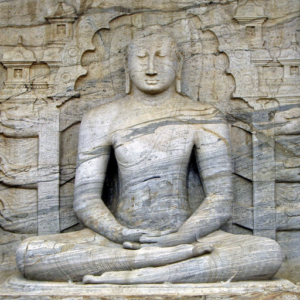
Emptiness in the Pali suttas [t = 0:35:03]
This text, the Madhyamakavatara, doesn’t really go into the pre-Nagarjuna history of the teachings on emptiness, or indeed the sources from the Pali suttas. So to find that, I went to some of the Theravada masters and specifically there’s a great website called ➜Access To Insight, which has more than 1000 suttas from the Pali Canon. Thanissaro Bhikkhu, one of the site’s authors, talks quite a lot about the suttas that discuss emptiness. He has a nice overview in his translator’s introduction to the ➜Maha-suññata Sutta (MN 122), where he says that there are three different approaches to emptiness in the suttas. I’d like to talk a little about each one.
(1) Emptiness as a meditative dwelling: here he suggests the primary source text is the ➜Cula-suññata Sutta (MN 121). Here the Buddha, who is talking to Ananda, says:
“Further, Ananda, the monk — not attending to the perception of the dimension of nothingness, not attending to the perception of the dimension of neither perception nor non-perception — attends to the singleness based on the theme-less concentration of awareness. His mind takes pleasure, finds satisfaction, settles, & indulges in its theme-less concentration of awareness.
“He discerns that ‘This theme-less concentration of awareness is fabricated & mentally fashioned.’ And he discerns that ‘Whatever is fabricated & mentally fashioned is inconstant & subject to cessation.’ For him — thus knowing, thus seeing — the mind is released from the effluent of sensuality, the effluent of becoming, the effluent of ignorance. With release, there is the knowledge, ‘Released.’ He discerns that ‘Birth is ended, the holy life fulfilled, the task done. There is nothing further for this world.’”
[MN 121]
We can already start to see that some of that language feels familiar: this idea that anything that is fabricated, mentally constructed, is impermanent and will fall apart. That is very much part of how we also think about emptiness in the Mahayana.
(2) Emptiness as an attribute of objects: Here the source is the ➜Suñña Sutta (SN 35.85):
“Then Ven. Ananda went to the Blessed One and on arrival, having bowed down to him, sat to one side. As he was sitting there he said to the Blessed One, “It is said that the world is empty, the world is empty, lord. In what respect is it said that the world is empty?”
“Insofar as it is empty of a self or of anything pertaining to a self: Thus it is said, Ananda, that the world is empty. And what is empty of a self or of anything pertaining to a self? The eye is empty of a self or of anything pertaining to a self. Forms… Eye-consciousness… Eye-contact is empty of a self or of anything pertaining to a self.
“The ear is empty…
“The nose is empty…
“The tongue is empty…
“The body is empty…
“The intellect is empty of a self or of anything pertaining to a self. Ideas… Intellect-consciousness… Intellect-contact is empty of a self or of anything pertaining to a self. Thus it is said that the world is empty.”
[SN 35.85]
This is a very classic Shravakayana presentation. We go through all of the five aggregates and the eighteen dhatus, and we say that each of these is empty. But it’s interesting, because if you look at this from a Madhyamaka perspective, you wouldn’t say, “Tongue is empty.” You would say, “There is no tongue.” Again if you compare what this sutta says, “Ear is empty, nose is empty …”, it sounds a lot like the Heart Sutra. But in the Heart Sutra we don’t say “Ear is empty, nose is empty …”, we say “No ear, no nose …” So we’re already starting to understand that there’s a different way that we talk about emptiness in the Madhyamaka, a different way we talk about self. We’ll see this later as we go through the differences between the Shravakayana or Theravada teachings and the Mahayana Madhyamaka teachings. And a lot of it has got to do with the notion of the Two Truths, where we talk about relative and ultimate, and all of these things are very much subsequent Mahayana developments.
(3) Emptiness as not-self: this is from the ➜Kaccanagotta Sutta (SN 12.15). A key passage is where the Buddha discusses right view, where he explicitly says that he avoids the extremes of existence and nonexistence and teaches “via the middle”:
Ven. Kaccayana Gotta approached the Blessed One and, on arrival, having bowed down, sat to one side. As he was sitting there he said to the Blessed One: “Lord, ‘Right view, right view,’ it is said. To what extent is there right view?”
“By and large, Kaccayana, this world is supported by (takes as its object) a polarity, that of existence & non-existence. But when one sees the origination of the world as it actually is with right discernment, ‘non-existence’ with reference to the world does not occur to one. When one sees the cessation of the world as it actually is with right discernment, ‘existence’ with reference to the world does not occur to one.
“By and large, Kaccayana, this world is in bondage to attachments, clingings (sustenances), & biases. But one such as this does not get involved with or cling to these attachments, clingings, fixations of awareness, biases, or obsessions; nor is he resolved on ‘my self.’ He has no uncertainty or doubt that just stress, when arising, is arising; stress, when passing away, is passing away. In this, his knowledge is independent of others. It’s to this extent, Kaccayana, that there is right view.
“‘Everything exists’: That is one extreme. ‘Everything doesn’t exist’: That is a second extreme. Avoiding these two extremes, the Tathagata teaches the Dhamma via the middle”
[SN 12.15]
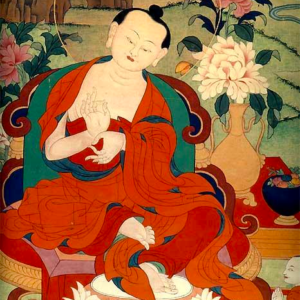
Nagarjuna himself says that this same sutta, the Kaccanagotta Sutta (which is also known as The Instructing of Katyayana) is the source upon which he based the Mulamadhyamakakarika. You can see this in Chapter 15 Verses 6 and 7 of the Mulamadhyamakakarika, where he says:
[15:6] Intrinsic nature and extrinsic nature, existent and nonexistent—
who see these do not see the truth of the Buddha’s teachings.
[15:7] In The Instructing of Katyayana both “it exists” and “it does not exist”
are denied by the Blessed One, who clearly perceives the existent and the nonexistent.
Part of the reason that I mention all this is that I was pleased to see that already there has been quite some discussion happening in the Forum, and one of the questions raised there was what is the right way to talk about non-self, not-self, no view of self, and so on – how should we understand this? I think it’s very easy to get confused with all of this, so we’ll talk about it more today. And I really encourage you to spend some time asking yourself what is your way of thinking about emptiness? How would you articulate it in terms of no-self or non-self or no view of self? Because there’s actually a difference.
Here we are in the Madhyamaka now, where Nagarjuna our founder is very clear that the Buddha has no views: neither existence nor nonexistence, nor neither, nor both. And yet we still have this challenge that we have all the relative teachings of karma and rebirth and how to uphold the Noble Eight-Fold Path, how to act in a way that is right rather than wrong. So we still have the same challenge: we somehow need a direction, even though we have no view. And in the teachings, the legend says that when the Buddha first taught the Heart Sutra at Vulture Peak Mountain, there were 500 arhats in the audience listening, and when they heard him teach the great emptiness they all had a heart attack and died. Perhaps this is a little poetic, but the point is fairly clear. This is a strong challenge to the way that emptiness was interpreted in the Shravakayana. So I really encourage you to debate, study, get on the Forum, have a friendly fight about these things – I think it’s really good to challenge your own understanding. And as Rinpoche said, as we go through this text, he really encouraged us not to see our opponents as ancient Indian philosophical schools that are dead and out of date ideas. But rather, how are they alive in us here and now, today? It could be in the way we approach the world. It would be in the way we approach the Madhyamaka. We will find that with a lot of these views that are held by our opponents, we are actually taking them on ourselves from time to time.
Chandrakirti will establish the view by showing there is no birth [t = 0:45:14] [MAV PDF page 6]
Now moving through the text, there’s too much here for me to comment in detail on everything that Rinpoche taught. There were 60 pages in the commentary for this week’s pre-reading, so I won’t be able to go through all of it. I think a lot of it is reasonably clear, so I’m going to spend more time on the areas that are less clear.
So how is Chandrakirti going to establish the view? He’s going to establish that there is no true existence by showing that there is no origin. A lot of what we’ll be talking about is the notion of origin or birth. As Rinpoche said, this is very much in keeping with our ordinary perceptions, because when we think about validating something we ask, “Where does it come from? Where was it made?” For example, if we see a Louis Vuitton bag – is it actually genuine? Or was it found somewhere on the streets of Bangkok, a fake? And we all intuitively understand there’s a difference between the truth or genuine article and the fake. But it’s not just that.
It really comes back to the questions we started reflecting upon last week, the perennial philosophical questions. How should we live? What is a good life? How should we understand what is true, what is good? And to answer these questions we need some kind of basis, some kind of foundation. We can’t simply say, as some contemporary mindfulness teachers might say, “Be non-judgmental.” Because then we have no way of making sense of what is good and what is bad. When should we turn left or turn right? We need some kind of view. We need some kind of basis for our action. And this is what we’re going to embark upon.
So let’s turn to page 11 in the text. I’ll give you the page references [in Introduction to the Middle Way, the PDF of Dzongsar Khyentse Rinpoche’s commentary on the Madhyamakavatara] as we go through the teaching, so that you can follow along in the book if you choose to.
THE MAIN BODY OF THE TEXT
Verse 1:1
The homage: in praise of compassion [t = 0:47:47] [MAV PDF page 11]
With the first four verses we start with a homage, in this case a praise to compassion. And as you may know in the Buddhist teachings, and certainly in the Indian tradition, it’s very traditional to show one’s respect for the lineage by offering praise and homage. And in this case, we have the praise to compassion.
[1:1] Shravakas and pratyekabuddhas are born from the Muni king;
Buddhas are born from bodhisattvas;
And, from the mind of compassion, non-duality and
Bodhicitta is born the bodhisattva.
So you might ask why would we praise compassion rather than wisdom? Why would we praise the bodhisattva rather than the Buddha and the Three Jewels? Traditionally when we offer praise in the Dharma, we offer praise to the Three Jewels: the Buddha, the Dharma and the Sangha. [MAV PDF page 12]
On page 12, Rinpoche also talks about the difference between the Shravakayana and the Mahayana. The path we choose to follow depends on our aim: are we seeking nirvana or are we seeking complete enlightenment? And this is a little bit ahead of where we are, but on page 169 Rinpoche says there are two kinds of listeners, and the Buddha taught for both of them. They have different kinds of motivation.
• [Shravakayana]: Some students have the motivation of wanting to free themselves from this worldly suffering. They can see it’s essenceless. They can see it’s pointless, and in the end it’s just going round and round on this wheel of samsara. And so they want to escape. And for them the Buddha teaches getting rid of [clinging to] the self, because it’s clinging to the self that causes all these problems of samsara.
• [Mahayana]: But there another group who aren’t just satisfied with liberation from samsara. They want liberation beyond all views. They want to go beyond samsara and also beyond nirvana. These are the bodhisattvas.
This text is directed towards bodhisattvas. It’s for a grander view, so we’re not just going to examine what is the way to nirvana, which is set out in the Shravakayana teachings, but what is the way to full and complete enlightenment? And part of what we’re saying here is that nirvana and enlightenment are not actually the same thing. We’ll talk a little bit about that also.
Verse 1:1cd
Compassion, nonduality and bodhicitta [t = 0:50:25] [MAV PDF page 14]
When we talk about why we praise compassion on page 14, we talk about the sequence of the three causes of the bodhisattva: the mind of compassion, nonduality and bodhicitta.
[1:1cd] And, from the mind of compassion, nonduality and
Bodhicitta is born the bodhisattva.
Nonduality is another way of talking about wisdom. When compassion and nonduality come together, that forms bodhicitta. You could say that the third is made up of the first two. And Rinpoche emphasized that yes, compassion is the starting point, but compassion on its own is not enough, because compassion without nonduality leads you to become a victim of your compassion. So when we say ‘compassion’, what is compassion? It’s more than just sympathy. It’s more than just feeling sorry for a person when we see them suffer. It actually involves a sense of understanding. If you were in her shoes, you’d understand what she’s going through. And as Rinpoche says, oddly under this definition even a cruel person, someone who is seeking to cause pain or suffering to others, you can argue they must have some kind of compassion somewhere, because they know the difference between what causes suffering and what does not cause suffering. Whereas by contrast if a tree branch falls on your head, the tree has no intention. It has no compassion. It has no ability to understand the difference between harm and non-harm. Sentient beings are different from trees in that respect.
So what might it look like to have compassion without wisdom? We can talk in contemporary ways about having boundaries that are not clear. As Rinpoche said, for example maybe we have goals around fixing people. And of course the bodhisattvas are not like that. Yes the bodhisattvas have compassion but they do not have goal-orientation, which perhaps for us beginners might seem a little odd. Because we’re thinking “Oh, I thought my aspiration was to help others?” Well, our aspiration is indeed for the enlightenment of all. But bodhisattvas themselves have gone beyond the dualistic understanding of self and others. So for them, their action is not motivated by this kind of dualism. As we’ll see later, the sun just shines. It doesn’t have an intention of shining upon a particular person. If a person wishes to receive some sunshine, they go outdoors and into the sun. The understanding of how a person relates to the Buddha is very similar. We’ll come to that also. If you go back to the Ten Bulls, and look at the image and poem for the 10th bull, it’s very similar: we have the sage in the marketplace. He’s not intentional [in the usual dualistic sense] about benefiting beings, but just through his presence he is able to benefit. This image is very much talking about the fruit of the bodhisattva path.
Another way of understanding the sort of compassion that gets us into trouble is for example that compassion without wisdom can lead to empathetic burnout. This is a challenge for a lot of people who are in care-giving professions such as nurses, but also for people like prison guards. There’s data that when prison guards retire, many of them die within the first couple of years after retiring. It’s that they’re so exhausted through having to deal with the demands of their roles.
Rinpoche recently taught in Mexico, and there he taught about how when we aspire to liberate all sentient beings, that might sound impossible. All sentient beings? How could I do that? I can barely have a positive influence on a few dozens of people in my life. It seems meaningless to talk about all sentient beings. And yet it doesn’t just function as an aspiration. It also functions as a ‘stretch goal’, as perhaps a manager might say, one that forces us to confront our assumptions. And it takes us beyond our rational understanding, because we can’t understand the idea of ‘liberating all sentient beings’ with our narrow rational concepts. So really we’re starting to approach nonduality.
Verse 1:2
Why does compassion come first? [t = 0:55:09] [MAV PDF page 16]
So we say that we start with compassion then nonduality, and then those two lead to bodhicitta. Why compassion first? Compassion comes first because it’s the seed, it’s the water that waters our plant, and then it is the fruit that the plant bears.
[1:2] Compassion alone is first seed for the abundant harvest of buddhahood;
Then water for its growth,
And finally, what matures as a state of lasting enjoyment –
Therefore, first I praise compassion.
Rinpoche often teaches about the difference between aspiration and application bodhicitta, and he says yes of course we want to engage in application bodhicitta, but it’s challenging. Whereas aspiration is good, it’s something we can all do, something there’s no reason not to do at any time. There’s no excuse for not having aspiration bodhicitta. So we can always start by cultivating compassion, and even if nonduality – the second stage – may be a challenge at the beginning, there’s no reason to not engage in compassion.
Now there was an interesting question during the 1996 teachings, not directly part of the commentary but when Rinpoche was answering questions, and someone asked him “Does the Buddha have compassion?” And here Rinpoche explained that the Buddha has no dualistic motivation. He has no subject and no object. So he benefits beings like the sun when it shines, or like a wish-fulfilling tree. And when we talk about the Buddha having compassion, that is a projection that we sentient beings are making or are putting onto the Buddha. His compassion is seen from our point of view. As Rinpoche said, bear in mind that his very existence is from our point of view. As we saw in the Heart Sutra and the Diamond Sutra, we can’t even say that the Buddha exists. So perhaps we are starting to become a little more familiar and comfortable with the idea that our naïve notions about the Buddha may not be entirely accurate. I think many of us are very familiar with a theistic approach to this. We think of the Buddha in almost god-like terms, and in many Asian countries people pray to the Buddha for good crops. They pray to the Buddha for success in business. It’s very theistic, as if there is some powerful person out there who can grant favours to us if he is pleased with us. It’s very dualistic. Whereas Rinpoche is very much encouraging us to apply the wisdom of the Middle Way to our understanding of the Buddha . If we can learn to get beyond our theistic habitual patterns and learn to see the Buddha as our projection, then we’re starting to have more of a nondual understanding.
Verse 1:3
Three types of compassion [t = 0:58:00] [MAV PDF page 19]
There are three types of compassion, distinguished by their objects, in other words distinguished by different kinds of beings with different kinds of defilements.
[1:3] Initially fixating on this so-called ‘I’ as an [existing] self,
‘Mine’ gives rise to grasping.
Helpless beings, driven as an irrigation wheel,
To compassion for these, I bow down.
And a lot of what this is going to help us understand is the stages of progression on the path.
• (1) Sentient beings experiencing the two kinds of suffering: The first kind of compassion is towards sentient beings who suffer from the suffering of suffering and the suffering of change. This is talking about the all-pervasive quality of dukkha (unsatisfactoriness) and anicca (impermanence) in samsara. And this is termed ‘common compassion’, because for example the Hindus also have it. And the objects of this first kind of compassion include all ordinary sentient beings, and also the shravakas and pratyekabuddhas on the path. In other words, anyone who is taking rebirth due to karma and emotion.
Verse 1:4ab [MAV PDF page 21]
For the second and third kinds of compassion, we now move to the first two lines of verse 4.
[1:4ab]: Sentient beings are as the moon’s reflection in moving water.
Seeing them as empty in their change and in their nature
Here we have an image, perhaps a lake on a windy night, where we can’t see a clear reflection in the surface of the lake because it’s choppy. Whereas if we go there on a calm day, then it’s all clear. This is already taking us to a preview of what we’re going to cover in Chapter 6.
• (2) Sentient beings experiencing the suffering of compounding: For the second type of compassion, the commentaries say we should place the emphasis on “moving water” and “change”. So in this analogy the lake is samsara, and the wind is karma, emotion, dualism and ego that stirs up samsara and leads to suffering. The analogy works very well, because when we are stirred up by emotion and ego, we can’t see clearly. The object for this second kind of compassion include all those sentient beings included as objects for the first kind of compassion, and also shravaka arhats and pratyekabuddhas who have already achieved their result, and all the bodhisattvas up to the 10th bhumi during their post-meditation.
This second type of compassion is also considered common compassion, because shravakas and pratyekabuddhas also practice this kind of compassion. However, there is a really big difference between the Mahayana and the Shravakayana paths, because in the Shravakayana, once you have attained the result of the arhat or pratyekabuddha, there’s nothing further to do at that point. Whereas here, we’re saying that these beings still have some defilements, therefore they’re still objects of compassion. We asked earlier: is the state of nirvana that the arhat has accomplished the same as enlightenment? The Shravakayana teachings would say yes, whereas here in the Mahayana we say no.
• (3) Sentient beings that do not fully realize emptiness: For the third kind of compassion, we put the emphasis on the words “reflection” and “empty”. The object of this kind of compassion is all those who haven’t fully understood the emptiness (or lack of true existence) of phenomena. This includes all the objects of the first and second kinds of compassion, and also all the bodhisattvas during their meditation time, up to and including the 10th bhumi. Only the Buddha is not included.
It’s considered uncommon compassion, because the realization of emptiness includes both the selflessness of the person and the selflessness of phenomena, which is only fully accomplished in the Mahayana. By contrast, the result of the Shravakayana path is nirvana, which corresponds to the realization of egolessness, and requires the realization of the emptiness (or lack of the true existence) of the person, but not necessarily the full realization of the lack of true existence of phenomena.
Note: The literal translation of the three types of compassion and their objects are:
• (1) compassion towards sentient beings (སེམས་ཅན་ལ་དམིགས་པའི་སྙིང་རྗེ་);
• (2) compassion towards phenomena (ཆོས་ལ་དམིགས་པའི་སྙིང་རྗེ་);
• (3) compassion without object (དམིགས་མེད་ལ་དམིགས་པའི་སྙིང་རྗེ་).
The above explanation of the three types of compassion follows Gorampa’s commentary on the Madhyamakavatara. Mipham explains them differently in his commentary. Dzongsar Khyentse Rinpoche has taught according to both commentaries on different occasions. For further information about the different explanations and how they relate to each other, please refer to the Glossary.
Now we might ask ourselves what is this final defilement that supposedly still remains to be purified when the bodhisattvas are on these final bhumis. Maitreya’s Uttaratantra-shastra lists nine defilements to be purified on the path (in verses 132-133), and these defilements become increasingly subtle as the bodhisattva advances on the path. By the time the bodhisattva is on the “pure bhumis” (the 8th to 10th bhumis), only one very subtle defilement remains, and in order to remove this defilement they must apply the strongest antidote, the ‘vajra-like antidote’ (Uttaratantra-shastra, verse 142). According to the Vajrayana and mahasandhi traditions, this final defilement is what they are seeking to purify.
Explaining the bodhisattva levels (bhumis) [t = 1:02:07] [MAV PDF page 24]
We now continue exploring the notion of how we think about progression on the path. What is a bhumi? It’s a combination of wisdom and method (also known as ‘skilful means’, Sanskrit: upaya). In Sanskrit, the word bhumi means ‘earth’ or ‘country’, and even today in Malaysia they used the Sanskrit-derived word bhumiputera to refer to the Malay race and indigenous peoples of South-East Asia, where putra means son and bhumi means earth or soil, hence ‘son of the soil’. And emphasizing that a bhumi is a combination of both wisdom and method, just as bodhicitta is wisdom and compassion. So compassion here corresponds to the Rupakaya, to form, to method, hence training in skilful means, the path to mastery. Whereas wisdom is the Dharmakaya, which corresponds to emptiness when we think in terms of form and emptiness. And as Rinpoche said, if you have wisdom but no method, then we’re talking about the path of the shravakas and pratyekabuddhas. But if you have method but no wisdom, then it’s just ordinary sentient beings. Back to what we said about mindfulness: you might have a technique, a method, but no wisdom.
And in terms of distinguishing these different bhumis, you cannot classify the bodhisattvas during their meditation state. In their post-meditation, you can recognize their qualities, but a lower bhumi cannot distinguish or recognize the level of a bodhisattva on a higher bhumi. And perhaps the most important point here is that when we talk about these bhumis, we talk about them as the extent to which the bodhisattva has eliminated defilements. So our progress along the path is measured not in terms of how much we are adding, but in terms of how much we are eliminating. And we attain a result that is the result of elimination (dreldré). Rinpoche taught this in great detail when he taught Maitreya’s Uttaratantra-shastra teachings on Buddha-nature.
Verses 1:4cd-1:5ab
The First Bhumi [t = 1:04:18] [MAV PDF page 26]
With the second two lines of Verse 4 and the first two lines of Verse 5 we now start the first bhumi. We have finished our homage and praise, and now we actually start the main text and the bhumis.
[1:4cd] The victorious one’s son, possessing such understanding,
And overcome by compassion, wishes to completely liberate all beings.
[1:5ab] Fully dedicated as in the Aspirations of Samantabhadra,
His joy is complete. This is known as the first.
You’ll see that Chandrakirti goes very quickly through the first five bhumis, quite possibly because he assumes that his readers are familiar with them. And indeed, the source text is the Dashabhumika-Sutra, the Ten Bhumi Sutra, and that sutra itself talks a lot about the ten bhumis. So there’s not a lot about them in this text, with the exception of the very detailed exploration of the sixth bhumi in Chapter 6. So if you haven’t had a chance to study the paramitas or the bhumis and you want to learn more, I’d encourage you to read texts such as Words of My Perfect Teacher, where the section on bodhicitta has a very nice introduction. Or indeed the classic text on bodhicitta, Shantideva’s Bodhicharyavatara. And in both cases, those go into much more detail on what is the content of these paramitas, and yes in both cases they also touch on the ultimate bodhicitta, which appears here in the 6th paramita of wisdom. But because Chandrakirti is taking a much more shortened approach, he’s really focussing on the nondual aspect of the paramitas. And he talks a little about contrasting what would be a dualistic practice with a nondual practice, in other words a practice that’s based on the view of the Middle Way.
View language and path language [t = 1:06:06] [MAV PDF page 27]
On page 27 there’s another very helpful question that Rinpoche answered by introducing path language and view language. I think this is important because already some of the questions you’re asking are touching on this distinction. For example, many of you are asking how does this nondual view, this ultimate view, apply to practice and to experience, because they seem like they should connect but how do we connect them? We’ll come to this later in Week 5 when we talk about the Two Truths, but for now we can already distinguish between view and path language. View language talks about truth – what is true? What is real? What ultimately exists or does not exist? And then path language is when we talk about the experience or the journey of the practitioner. It’s much more subjective, much more about questions like – how can I have devotion to the guru? How can I practice so as to abandon defilements? As Rinpoche points out, these are two different kinds of question. This is going to be a challenge, and I imagine we’ll be getting caught in this in the coming weeks. But I wanted to say it now. When you have a question, just think to yourself – am I asking a question about view or am I asking a question about path? Is this about view language or about path language, because they’re different. As we see in the sutras, one is more about ultimate truth and one is more about relative truth. And yes in the end we will find a way of relating them to each other, but it’s really important to understand they’re different.
If there’s no enlightenment, what’s the point of practice? [t = 1:07:55]
As Rinpoche says, we need the path language to encourage practitioners like us. And part of the challenge is that teachings that talk about the path are all relative teachings. They’re provisional teachings rather than definitive teachings. So in a sense all of the path teachings could be said to be untrue to some degree, or ‘fake’ as Rinpoche says. Yet we still need to practice them. We still need to hear and practice these teachings in order to realize the view. As Shantideva famously said, yes our path is all about getting rid of and giving up our defilements and our ignorance, but the last defilement, the last ignorance that we want to give up is the idea that there is enlightenment. Ultimately, as Nagarjuna said, we want to arrive at a place where we have no views. As the Diamond Sutra says, even the Buddha, even enlightenment: we cannot say these things exist. But if we say that too soon, if we’re not yet ready, if we give up that aspiration when we haven’t travelled the path and we haven’t done removed our other ignorance and our other defilements, then we might just become nihilistic. We might just give up. We might just say “If there’s no enlightenment, what’s the point of practice?” And then we would accomplish nothing. We would completely ruin our Dharma because we would just settle with our ignorance untouched. So again, it’s very paradoxical, as we’ll find so often in this teaching. We need to have a path, even though the path is fake, because this fake path is the only thing that can lead us to realizing the truth. It’s a big paradox.
Verse 1:5cd
What does it mean to be a bodhisattva? [t = 1:09:52] [MAV PDF page 27]
Now we ask what does it mean to be a bodhisattva, and we will first talk about the name. To what kind of person are we giving this name ‘bodhisattva’?
[1:5cd] With this attainment, from now on
He is known as a bodhisattva
Here in Verse 5 we say we can do this in two ways. Either by action and practice, or by the view.
(1) Defining what is means to be a bodhisattva by action (practice)
When we assign the name by action and practice, here we need to reflect on what Shantideva talked about in terms of ‘entering bodhicitta’ and ‘application bodhicitta’. The wish or aspiration is different from the entering or application. And when we start, as Rinpoche said yes aspiration is good, but just having an aspiration, just having a passing wish to enlighten all sentient beings, that is different from committing oneself to the path. And application bodhicitta or entering bodhicitta only begins when you make the commitment that from that point onwards everything that you do will be for the sake of enlightening all sentient beings. In more contemporary terms, we might say it’s an existential choice. The Wikipedia entry on ➜existentialism says:
Authentic existence involves the idea that one has to “create oneself” and then live in accordance with this self […] The authentic act is one that is in accordance with one’s freedom.
So there is this notion that we have to change the story that we’re telling about ourselves, about who we are, about what our life is about – what is our purpose? We have to engage in very deliberate self-authorship where we now author ourselves as bodhisattvas. There’s an explicit recreation or creation of a new identity for ourselves. And at that point we can consider ourselves bodhisattvas as defined by action or practice. So this is a great distinction to reflect upon for yourself. When you think about your narrative, when you think about how you describe your passion, your purpose, what your life is about, what your work is about, how you relate to the world, to relationships, to work – how are you doing this? What is your narrative? When somebody asks you why are you doing this, what answer do you come up with? And is the answer, “because I want to bring all sentient beings to enlightenment”? Is that your answer? It’s a great reflection.
(2) Defining what it means to be a bodhisattva by view (realization)
The second way of defining a bodhisattva is by view or realization. In this case, it’s when the bodhisattva has a direct experience of emptiness. This is the first bhumi and the Path of Seeing.
Verses 1:6-1:7abc
The qualities obtained [t = 1:12:52] [MAV PDF page 29]
The next part of the text goes into the qualities obtained, starting with verse 6. In the next few verses, the language becomes quite poetic, very inspirational, and I think most of it is fairly straightforward.
[1:6] Now born into the family of the Tathagatas
Completely abandoning the three constant fetters,
The bodhisattva possesses supreme delight
And is able to stir a hundred worlds.
[1:7abc] Joyfully progressing from bhumi to bhumi
The various paths to the lower realms have ended;
The levels of ordinary existence are exhausted.
Verse 1:7d
The eighth sublime level [t = 1:13:08] [MAV PDF page 32]
I’d like to mention the last part of verse 7, where the text reads:
[1:7d] This is taught to be like the eighth sublime level.
There are four stages of enlightenment in the Shravakayana or Theravada teachings, which are divided into eight levels. And what we’re saying here is that the beginning of the 1st bhumi corresponds to what in the Shravakayana is termed ‘Stream-winner’, which means you have at most seven more rebirths before enlightenment. The four stages of enlightenment are Stream-winner (Sotapanna), Once-returner (Sakadagami), Non-returner (Anagami) and finally the Arhat (Arahant). There’s a big debate here in the commentaries about what is meant by the ‘eighth sublime level’. Rinpoche didn’t go into it and I don’t think we need to go into it, but Chandrakirti would like us to understand that the Mahayana teachings on the bhumis can be understood alongside the Shravakayana teachings on the stages of enlightenment.
Sudden and gradual [t = 1:14:09]
There is also an important point here about the distinction between sudden and gradual, which is emphasized in the Shravakayana. It’s about how gradual or continuous change – in other words continuous practice where we’re slowly working on ourselves and purifying our defilements – can lead to a discontinuous result. One of our everyday ways of talking about this is ‘the straw that breaks the camel’s back’. We can keep adding straw to the back of our camel, and at a certain point there will be just one piece of straw – which in and of itself may seem insignificant – but that one straw is more than the camel’s back can bear, and so it breaks. So there’s a gradual or continuous change slowly, slowly, slowly accumulating – with a sudden or discontinuous result. And this is very much the way this is taught in the Sutta Pitaka: progress in understanding comes all at once. What is called ‘insight’ (abhisamaya) does not come gradually. Each of these four levels is attained suddenly, and even the final realization of the fruit is also sudden.
We have lots of contemporary ways of understanding this and relating it to our own experience, for example when we’ve been working on something for a long time and then perhaps we fall asleep and we wake in the morning with an ‘a-ha moment’ when it all comes together and we can see clearly. We have that insight. Even in our everyday lives we have that experience of how we can be working on something for a long time seemingly without any obvious signs of progress, and then it can lead to a sudden insight. That’s very much the way we should understand progress on the Dharma path. In the Zen tradition, there’s the notion that you can have an initial insight or satori, but then there is the need for gradual training to ensure that this experience develops into realization. That’s how we can understand sudden and gradual together, and the bhumis or bodhisattva stages have a similar quality where gradual or continuous practice leads to discontinuous or sudden transitions from one bhumi to the next.
Verse 1:8
The quality of outshining others [t = 1:16:21] [MAV PDF page 33]
The next important verse is verse 8. As Rinpoche said, in the shedras, the monastic colleges, they spend many weeks just on this one verse.
[1:8] Striving for enlightenment, even when remaining on the first level,
He defeats those born from the speech of the Sage King, including solitary realizers.
And, through ever-increasing merit,
On “Far Gone”, his understanding also becomes greater.
And it’s all around what is it that allows us to say when a bodhisattva can outshine a shravaka arhat or pratyekabuddha. On the 1st bhumi, we say that already the bodhisattva can outside these arhats by the strength of his or her merit, but not yet by the strength of his or her wisdom. So when we say ‘the strength of their merit’, there’s a good example here of a king surrounded by his ministers, and then in comes the queen holding the baby prince. And already the baby prince outshines all the ministers. So even though these ministers may be very wise, very noble and experienced, they will never be king. But the baby prince one day will be king. He has that merit. The analogy is that as a consequence of their greater compassion and the merit they have accumulated over eons of practice, the bodhisattvas have the merit that will lead them to complete enlightenment.
But the bodhisattvas do not outshine the arhats by the strength of their wisdom until they complete the 6th bhumi and enter the 7th bhumi. Here’s where it gets a little bit technical, and we’ll need to introduce some Tibetan terms here as we talk about some of the different defilements on the path.
First an analogy. The understanding of emptiness of the shravaka arhats and pratyekabuddhas is like a tiny insect eating inside a mustard seed, which as you know is a tiny seed, and creating a space inside there. Whereas the bodhisattvas’ understanding of emptiness is as wide as the sky. So we might ask, if the bodhisattva has a greater understanding of emptiness, why doesn’t he also outshine the shravakas with his wisdom?
Dendzin and tsendzin [t = 1:18:45] [MAV PDF page 35]
In order to answer this question, we introduce a couple of different obscurations or defilements:
• Dendzin: this is clinging to true existence, really believing there is a self, which gives rise to self-clinging, emotions and suffering. And as we discussed last week, that is the cause of samsara – this dendzin or clinging to true existence.
• Tsendzin: even after one has overcome that clinging to true existence, there’s still another defilement remaining, called tsendzin, which is translated here as ‘fixation on characteristics’. We can understand this as follows: even if we don’t think something truly exists, we still have dualistic perceptions. We still have subject and object. We still think of things in terms of good and bad. We have reifications. We draw boundaries around objects with our words, with our language, with our thoughts. All of that, all of that creating some kind of characteristics in the world, that is tsendzin. If we wanted to step back a little bit, at some level we know the world is a complex set of interactive, interdependent phenomena and pre-linguistically where you would draw the boundary around any one phenomenon is very much conventional. It’s an arbitrary choice that depends very much on how you want to interact with and ‘use’ the phenomenal world. And so we rapidly start to realize that a lot of these things that we call ‘phenomena’ are just our inventions. They’re just our creations. And nevertheless, once we create words, once we create these distinctions, it’s easy for us to forget that they’re just things we’ve made up and we start to take them very seriously. That is tsendzin.
• Nyinang: Later (on page 64) Rinpoche talks about another defilement, nyinang, which is still present from the 8th to the 10th bhumis. It’s translated as ‘mere apprehension’ and as Rinpoche says, at that point, from the 8th bhumi onwards, there’s no more appearance – let alone fixation on appearance. There’s no more perception. And yet there’s still some kind of subjectivity. If we look at nondual practices such as mahamudra and mahasandhi, they are working to purify this kind of defilement or obscuration where there is no appearance or perception but nevertheless there is still some kind of subjectivity.
Going back to our question about outshining, the reason we say that bodhisattvas can’t yet outshine the shravakas, even though they understand emptiness to a much greater degree – like the sky versus the hole in the mustard seed – it’s because they cannot make the removal of their tsendzin irreversible. During their practice, during their path, the attachment to these characteristics, which is a defilement, but even as they’re removing it they’re still creating causes for new tsendzin, as long as they’re on the first six bhumis. It’s only once they reach the 7th bhumi that they’re no longer creating causes for tsendzin, and at that point we would say they outshine the shravaka arhats.
The superior understanding of one’s own object [t = 1:22:27] [MAV PDF page 36]
Now when we talk about the understanding of emptiness, what exactly are we talking about? The commentary introduces Nagarjuna’s understanding of this point, which he explains in terms of ‘the superior understanding of one’s own object’. The commentary breaks this phrase into three parts:
• (1) One’s own object: If you look at page 37, you’ll see that we don’t just talk about existence and nonexistence. Instead, we talk about a four-fold classification of existence, non-existence, both and neither.
This is called the catuskoti, which is found in classical Indian logic, and it is very much the base for Nagarjuna’s famous logical argument called the ‘Diamond Slivers’. And going back to what I said earlier about the relationship between Buddhism and ancient Greek philosophy, this four-fold logic also appeared in Pyrrho’s skeptical philosophy. This is very interesting, as in most western logic there’s nothing like this four-fold logic. Instead, there’s what is known as the Law of the Excluded Middle – a proposition can either be true or it can be false, but in classical logic there’s no third let alone fourth option. As Rinpoche often says, Buddhist logic is different from western logic, and certainly this idea of a two-fold rather than a four-fold logic – they are different, and we’ll see this as we go through the analyses. But it is also interesting, on that note, to observe that contemporary logic goes beyond the classical two-fold Law of the Excluded Middle.
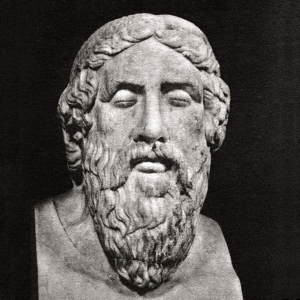
The Liar’s Paradox and the ‘hard problem’ in consciousness [t = 1:24:20]
And even in ancient Greece we had some examples where this seemingly robust classification – either it’s true or it’s false – started to fall apart. And the most classic example is the Liar’s Paradox, which you may know. This was originally from a Greek thinker called Epimenides, who was from Crete and lived around 600 BCE, and he was reported to say, “All Cretans are liars.” And of course this statement is paradoxical: if what he just said is true, then he has uttered a true statement, which means that not all Cretans are liars. And yet if he’s lying when he says “All Cretans are liars” then it means some Cretans must tell the truth. A simpler version of the same thing is the statement “This statement is false”. Just those four words are paradoxical. And some of you may have read Douglas Hofstadter’s wonderful book Gödel, Escher, Bach, which talks about Gödel’s Incompleteness Theorems in pure mathematics, and one of the classic proofs of Gödel’s Theorem works with this exact idea of constructing mathematical sentences which have these paradoxical qualities.
And it’s interesting, because this area of investigation is becoming very lively in the contemporary philosophy of consciousness and cognitive science, which we’ll come to in Week 5, and even Hofstadter said of his book – which is seemingly about mathematics, art and music – that it’s not really about that. It’s about how cognition emerges from hidden neurological mechanisms. This is very much related to the so-called ‘hard problem’ in the philosophy of consciousness: how do we explain subjective experience when seemingly it’s emerging from physical foundations, in other words the brain. How does consciousness emerge from the brain? We’ll come to that, and it’s very much taking us back to the Yogachara school, the Chittamatra, who are very much proponents of – and have a very robust position on – the Mind-Only and consciousness. And it’s very tempting to accept their view given our intuitions about what it is to be conscious. This was famously expressed by Descartes when he said “cogito ergo sum” (“I think, therefore I am”). When we go back to what is valid, what counts as valid cognition, and what is true – for Descartes the fact that he could actually experience his own consciousness, his own subjectivity – that seemed incontrovertible to him. How could we argue with that? We’ll confront that later on.
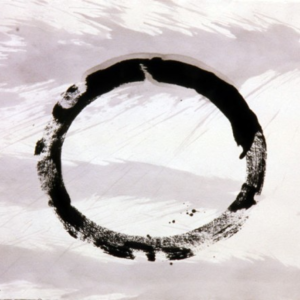
Understanding non-self: emptiness is not the same as non-existence [t = 1:27:28]
We’ve have already seen that Nagarjuna is not just talking about how things are non-existent. That is the Shravakayana approach – establishing that self does not truly exist. But here in the Madhyamaka we want to go beyond all four corners of the catuskoti: not just elimination of clinging to the self, in other words clinging to existence, but also elimination of clinging to non-existence, clinging to both, and clinging to neither. This – going beyond all four extremes – is what we call the ‘great emptiness’, which is the emptiness of emptiness, and we’ll talk about this in Week 6. Another common misunderstanding is the difference between emptiness and non-existence. When we talk about emptiness, what we’re talking about is this great emptiness that is beyond the four extremes. And it’s not the same as non-existence, which is only going beyond one of the four extremes. So this is a source of potential confusion and misunderstanding between some of the Shravakayana texts and some of the Mahayana texts. If you look at the literal definition of nirvana, it means ‘blowing out’ or ‘quenching’, which is traditionally understood as the extinction of the three fires or three poisons of passion, aversion and ignorance. And when these fires are extinguished, then release from the cycle of rebirth is attained. So in the Shravakayana, the attainment of nirvana has the connotation of getting rid of the false attachment to self that gives rise to the three fires or the three poisons. Whereas in the Mahayana, we don’t just talk about ‘getting rid of’. Yes, we say form is emptiness, in other words we get rid of clinging to false ideas of existence. But in the Heart Sutra we also say emptiness is form, thus getting rid of false ideas of nonexistence. We end up once again with this paradoxical understanding that goes beyond our ordinary rationality.
As I mentioned earlier, there was a discussion in the Forum about what do we mean by non-self, and in the Madhyamaka when we say ‘non-self’, I’m using that word as shorthand to summarize Nagarjuna’s view that the self neither exists nor doesn’t exist nor both nor neither. We will also refer to this view as ‘beyond extremes’ and ‘nondual’, as Nagarjuna’s view of the Middle Way goes beyond all dualistic extremes. And we should always remind ourselves that this ‘view’ of emptiness is actually a non-view that goes beyond all views. As Nagarjuna himself said “The wise one should not even remain in the Middle”. As Rinpoche emphasized, we can try to talk about this, but because it’s so paradoxical, it very quickly goes beyond the language and thought of our rational understanding. As we discussed in Week 1, the only way we can really understand emptiness is through meditation. Talking about it just makes it worse. And as we saw earlier, if you look at the Liar’s Paradox or Gödel’s Theorem, you will see that language, dualistic concepts and rational descriptions break down at a certain point. They’re not enough to describe or bring us to this state of nonduality.
So now what is the “object” that is understood when one has an understanding of emptiness, which Nagarjuna here refers to as “one’s own object”. In summary, what is understood is not merely the Shravakayana view of the lack of true existence of the self, but we understand the view of emptiness beyond all extremes of existence, nonexistence, both and neither.
Do shravakas and pratyekabuddhas understand the emptiness of phenomena? [t = 1:30:30] [MAV PDF page 38]
Next is the second aspect of “superior understanding of one’s own object”, namely “superior”:
• (2) Superior. Here we talk about how much do the shravakas and pratyekabuddhas understand the lack of true existence of phenomena? In what way can we say that the understanding of the emptiness of phenomena is superior in the Mahayana?
We know that shravakas understand the emptiness of the self of the person, as otherwise they could not attain nirvana. But if they also understand the emptiness of phenomena then one might argue why do we even need the Mahayana path, because that’s where all that is taught. Bhavaviveka, one of the early commentators on Nagarjuna’s Mulamadhyamakakarika, argued that because the shravakas are only interested in nirvana, they don’t care about the emptiness of phenomena. But Chandrakirti disagrees and says no, if they attain nirvana and understand the emptiness of the self then they must also understand some aspect of the emptiness of phenomena. This is because they must understand the emptiness of the five aggregates that constitute the self. And indeed the Buddha taught this.
In the ➜Phena Sutta, one of the Pali suttas, there is a famous verse that describes the emptiness of phenomena:
Form is like a glob of foam; feeling, a bubble; perception, a mirage; fabrications, a banana tree; consciousness, a magic trick — this has been taught by the Kinsman of the Sun. However you observe them, appropriately examine them, they’re empty, void to whoever sees them appropriately […] That’s the way it goes: it’s a magic trick, an idiot’s babbling. It’s said to be a murderer. No substance here is found.
[SN 22.95]
If you’re interested in why is it said to be a murderer, that’s from another Pali sutta, the ➜Yamaka-Sutta, where Shariputra tells the story of somebody who knows a rich householder and wants to steal their money, and who then poses as a servant, gains their trust, and then kills them. After telling the story, Shariputra asks Yamaka, is it not true that although this person was a murderer, the householder did not know him as a murderer? Yamaka says yes, and Shariputra continues by comparing this story to how we confuse our body and our self:
In the same way, an uninstructed, run-of-the-mill person — who has no regard for noble ones, is not well-versed or disciplined in their Dhamma; who has no regard for men of integrity, is not well-versed or disciplined in their Dhamma — assumes form (the body) to be the self, or the self as possessing form, or form as in the self, or the self as in form.
[SN 22.85]
What he’s saying is that when it comes to these wrong views of self, and in particular how we relate self and body – which we’ll come to later with the famous example of the chariot – attachment to these wrong views is considered to be just as misleading as the murderer posing as a faithful servant. We impute solidity but in reality, as the Buddha says, it’s a magic trick. It’s an idiot’s babbling. No substance there is found.
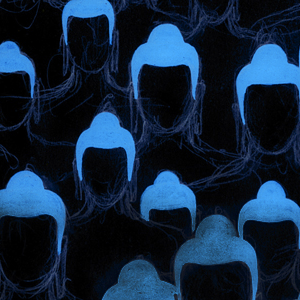
You may have seen that there’s a lovely new translation available on the Khyentse Foundation website of the Vimalakirti Sutra (The Sutra of The Teaching of Vimalakirti), which is considered the jewel of all the Mahayana sutras. It’s a free download of Robert Thurman’s new translation, which also contains a really wonderful introduction by Rinpoche and some lovely artwork. It contains a section (on page 114 of the PDF) that expresses the emptiness of the body in a very similar way to the Phena Sutta:
This body is like a ball of foam, unable to bear any pressure. It is like a water bubble, not remaining very long. It is like a mirage, born from the appetites of the passions. It is like the trunk of the plantain tree, having no core. Alas! This body is like a machine, a nexus of bones and tendons. It is like a magical illusion, consisting of falsifications. It is like a dream, being an unreal vision. It is like a reflection, being the image of former actions. It is like an echo, being dependent on conditioning. It is like a cloud, being characterized by turbulence and dissolution. It is like a flash of lightning, being unstable, and decaying every moment.
Another classic example is the concluding section of the Diamond Sutra (section 32), which has the classic expression:
All conditioned phenomena
Are like a dream, an illusion, a bubble, a shadow,
Like dew or a flash of lightning;
Thus we shall perceive them.
In all these ways, then, we’ve just talked about how the understanding of the emptiness of phenomena is superior on the Mahayana path because although on the Shravakayana path we understand that phenomena are empty and lack true existence in the way just described, in the Mahayana path we not only establish their lack of true existence, but we go completely beyond all four extremes. They neither exist, nor don’t exist, nor both nor neither. And the Mahayana also has teachings on the paramitas, compassion, and so on. So in that way it is superior.
• (3) Understanding: Finally, on page 41, we come to the third aspect of “superior understanding of one’s own object”, namely understanding. The Mahayana teaching is said to be superior because it’s clearer, vaster and more complete. So once again we say that the emptiness taught in the Shravakayana is narrow and limited, whereas here in the Madhyamaka we talk about 20 different kinds of emptiness which negate all of the four extremes.
Defining ignorance and wisdom [t = 1:35:58] [MAV PDF page 42]
I’d like to make a brief comment on ignorance. We talk a lot about wisdom, which is the opposite of ignorance, and it’s a very challenging and misleading word for many of us when we first approach these teachings, because the normal English understanding of ‘ignorance’ means something like ‘not knowing something’ or ‘lacking information’. Here’s the dictionary definition:
Ignorance: lack of knowledge or information.
synonyms: incomprehension of, unawareness of, unconsciousness of, unfamiliarity with, inexperience with, lack of knowledge about, lack of information about.
If we look at the definition of wisdom, it’s a little better because there’s more on experience and good judgment, but the sense is still that experience brings wisdom because you know more:
Wisdom: the quality of having experience, knowledge, and good judgment; the quality of being wise.
synonyms: sagacity, intelligence, sense, common sense, shrewdness, astuteness, smartness, judiciousness, judgment, prudence, circumspection.
Some of these more relative aspects of wisdom are very relevant for us in our practice, as the Noble Eight-Fold Path is also a practice of acting wisely in the relative world. But now when we’re establishing the view, when we talk here about wisdom, we mean the result of elimination. We wish to eliminate our ignorance and defilements. Likewise, the Tibetan word for the Buddha, Sangye, means ‘purified’. We praise the Buddha for being awakened. Being awake means an absence of sleep. We don’t praise him for being powerful or beautiful or things like that. There’s a nice explanation on the Wikipedia page on ➜avidya (ignorance), where it says:
Avidya is explained in different ways or on different levels within different Buddhist teachings or traditions. On the most fundamental level, it is ignorance or misunderstanding of the nature of reality; more specifically about the nature of not-Self and dependent origination doctrines. Avidya is not lack of information, states Peter Harvey, but a “more deep seated misperception of reality”. Gethin calls Avidya a ‘positive misconception’, not mere absence of knowledge. It is a key concept in Buddhism, wherein Avidya about the nature of reality, rather than sin, is considered the basic root of Dukkha. Removal of this Avidya leads to overcoming of Dukkha.
As Rinpoche says, it’s not that we don’t know enough. It’s that we ‘know’ (or believe in) things that are incorrect. We have constructed an illusion, a hallucination, a mirage – we see something there, we posit something as existing, when it is not there.
Dualism and nonduality [t = 1:38:35] [MAV PDF page 43]
This brings us to nonduality. We are familiar with everyday dualistic distinctions like good and bad, beautiful and ugly and so forth, and those are also included with the conceptions and characteristics of tsendzin. And yes we know that it does not make sense to talk about something like a truly existing beautiful person. If a person possessed the characteristic of truly existing beauty, then everyone would have to see him or her as beautiful. Remember we define true existence as being independent of causes and conditions, so if there were such a thing as truly existing beauty then everyone would experience it the same way. But we know full well that beauty is in the eye of the beholder. We don’t all perceive people the same way. We know beauty isn’t truly existing, and we know that kind of dualistic conception does not work.
But in the Madhyamaka the understanding of nonduality is even more fundamental, because we are not just saying that objects do not have any truly existing dualistic characteristics such as beautiful and ugly. We are saying that there are no separate solid entities of subject and object in the first place. As Rinpoche says, when we get caught in dualism we’re actually “divorcing subject and object”. Some of you asked questions about what we mean by dualism, and that’s what we mean.

Going beyond subject and object [t = 1:39:37]
Intriguingly there are some real overlaps with a lot of the western tradition here. In particular, I’d love to draw your attention to the work of Bob Kegan, Professor of Adult Learning and Professional Development at Harvard, who is a leading expert in adult development. There’s a lovely quote from an article “Epistemology, Fourth Order Consciousness, and the Subject-Object Relationship”1, where Kegan is talking about development through the human lifecycle, and how that relates to dualism and the whole notion of subject and object:
We start from a position, in earliest infancy, where there’s absolutely no subject-object distinction at all, because the infant’s knowing is entirely subjective. There’s no “not me,” no internal vs. external. There’s no distinction, for example, in the source of the discomfort caused by bright light or hunger in the belly. There’s no distinction between self and other.
As you may know, in the first few months after birth, a baby doesn’t know that its hands and feet are its own. It can’t even distinguish between itself and its mother. Kegan continues:
The ultimate end state of this story — of this process of gradually but qualitatively shifting more and more of what was subject to object — […]
Here in parentheses we might add that a lot of the triumph of rationality and the Enlightenment tradition in the West was about the birth of a worldview based on science and objectivity. Again, it’s about how we move from subjectivity (and irrationality) to objectivity (and rationality). As Kegan says, as we keep gradually shifting more of what was subject to object, our endpoint:
[…] would be a state in which the subject-object distinction comes to an end again, in the opposite direction than in the first minutes of life. You know, in the sixties, Alan Watts was fond of saying that his baby was a buddha. But that showed a total misunderstanding. There are two different ways that you can get out of the subject-object split. One way is by being entirely subject with no object — that was Watts’ baby. And the other way is through the complete emptying of the subject into the object so that there is, in a sense, no subject at all — that is, you are not looking out on the world from any vantage point that is apart from it. You’re then taking the world’s perspective. That’s the Buddha. There’s an enormous difference between the nondualism1Note: Kegan’s original has “adualism” instead of “nondualism”. of an infant and the nondualism of the Buddha.
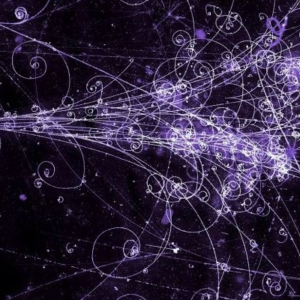
Emptiness, nonduality and dependent arising [t = 1:42:28]
Some of you asked how we might distinguish emptiness, nonduality, dependent arising, interdependence and so forth. These are all terms that will shall encounter a lot, and we’ll develop a fuller definition over the coming weeks, but just briefly:
• Emptiness: here we’re going to follow Nagarjuna’s understanding where we use ‘emptiness’ to refer to the emptiness of emptiness, which is neither existence, nor non-existence, nor both, nor neither. Beyond even resting in the Middle. This refers to ultimate truth.
• Nonduality: this is also beyond subject and object, although as you just saw in the quote from Kegan, there’s a way of understanding that which is more like the Buddha, and another way which could be total subjectivity, which is not what’s intended here. That just leads to total narcissism. It’s also interesting to note, going back to the Pali suttas that we quoted earlier, that Thanissaro Bhikkhu talks in his commentary about emptiness being an attribute of an object. The Pali suttas say things like “the eye is empty, the nose is empty, the ear is empty …” and so on. But from a Mahayana perspective that’s still considered dualistic, because we are still distinguishing a phenomenon (an object) that has the attribute of being empty. For example, we’re still distinguishing an ear – that’s tsendzin, a characteristic, a label, some ‘thing’ that we’re calling an ‘ear’. And even though we’re saying it’s empty, there’s still a subject-object relationship. The nonduality that we’re talking about in the Mahayana is different from the Shravakayana understanding of emptiness as an attribute of the five aggregates. So this should also help us to have a better idea of why the Mahayana understanding of the emptiness of phenomena is considered superior to the Shravakayana understanding.
• Dependent arising: now we’re talking about conventional phenomena, and how things arise and emerge in the world. This is now a discussion of relative truth, and as we think about how anything functions in the relative world, we know it’s all interdependent. We are unable to untangle the complex totality of spatial and temporal relationships of cause and effect that characterize our phenomenal world. We’ll come back to this in Week 6.
[MAV PDF page 43]
As Rinpoche says, there’s actually only one ignorance – namely, clinging to phenomena as having a truly existing self. However, we can divide this ignorance into clinging to the self of the person and clinging to the self of phenomena for our purposes in refuting wrong views and establishing emptiness in this text. Specifically, Chandrakirti will establish emptiness in two stages. First, as it is to be understood by all vehicles, including the Shravakayana and the Mahayana. Then, as it is to be understood exclusively within the Mahayana, noting the various ways in which the Mahayana teaches the ‘superior understanding of one’s own object’ that we talked about earlier.
But it is relevant for us, especially when we get to Week 5 on refuting clinging to the self of the person, as a lot of the contemporary philosophy of mind, philosophy of consciousness, phenomenology – does go into this topic. And indeed there’s a very active contemporary debate on these topics, which you may have come across if you have followed any of the Mind and Life conferences, where His Holiness the Dalai Lama has been meeting with leading neuroscientists. There’s a lot of discussion there about how might one extend the third-person objective methods of science to the first-person experiences of consciousness. Does that even make sense? There are some very interesting debates about what does that all mean, and we will be able to make better sense of them in the light of our understanding of nonduality.
But as Rinpoche says, if you look at which is a bigger category, the self of phenomena is bigger than the self of the person, because the person is just one phenomenon. So it’s possible to abandon clinging to the self of the person, which is what happens in the Shravakayana path, and nevertheless still be left with some clinging to the self of phenomena. So that is why we would say the Mahayana path, the Madhyamaka path, is superior.
Verses 1:9-1:15
The First Bhumi: Generosity [t = 1:46:11] [MAV PDF page 45]
Next we turn to the qualities of the paramitas themselves starting with verse 9, which talks about the paramita of generosity. Most of these verses are pretty straightforward.
[1:9] Here, the first cause for perfect enlightenment,
Generosity, is the most important.
Giving his flesh with enthusiasm,
Infers what is not seen.
[1:10] Ordinary individuals, craving happiness,
Cannot live without comfort.
Recognizing that comfort comes from generosity,
It was this the Muni spoke of first.
[1:11] Uncompassionate, extremely insensitive,
Striving solely for personal benefit –
Even such individuals will obtain comforts,
And have all sufferings pacified, through generosity.
[1:12] Furthermore, practising generosity,
They will swiftly meet with a superior,
Completely cutting the stream of samsara.
Having such a cause, they proceed to the yield of peace.
[1:13] Those pledged to others’ welfare,
Will soon gain happiness through generosity.
Hence, for those with compassion and those without
The importance of generosity is stressed.
[1:14] When hearing or thinking of “give!”
The pleasure of a bodhisattva
Exceeds the pleasure of the arhat’s nirvana,
Not to mention [the joy of] giving everything.
[1:15] Suffering when cutting and giving his body,
He realizes the pain
Others endure in the hells and so forth.
He thus endeavours in eradicating suffering.
Verse 1:16
What is a paramita? [t = 1:46:19] [MAV PDF page 49]
I’d like to say a couple of words on verse 16, where Chandrakirti distinguishes what can be called a paramita. It’s similar to the earlier discussion about what can truly be called a bodhisattva.
[1:16] Giving, which is empty of giver, gift and receiver –
Is known as transcendent paramita.
Attachment to these three
Is taught as being ordinary paramita.
Here he says that paramita means ‘gone beyond’, and therefore the paramita doesn’t even exist on the 1st bhumi because as we’ve seen, we don’t go beyond until later. Because we still have all this tsendzin on the first six bhumis. So we can distinguish three different kinds of paramita:
• Transcendent paramita of generosity: the true paramita or transcendent paramita is when we engage in generosity without any concept of a gift, a giver or a receiver. There’s no subject, no object, no action – that’s truly a nondual perspective, one that’s beyond tsendzin and beyond duality.
• Ordinary paramita of generosity: this is when you are still attached to the subject, the object and the action as real. You still have dendzin. This corresponds to the bodhisattvas still on the path or sentient beings like us.
• Worldly generosity: this is just being a nice person. We might do nice things for our friends and so on. We might be generous. But as we saw earlier, if you haven’t yet made this choice, this commitment that all of your action is for the sake of enlightening all sentient beings, it cannot even be considered an ordinary paramita. For it to be considered an ordinary paramita, you must be at least a bodhisattva as defined by your action. In other words, you must have gone beyond mere aspiration to entering bodhicitta, the idea that you are committing yourself and your life – all of your actions, your purpose, your narrative – to be for the enlightenment of all sentient beings.
Verse 1:17
Why can’t we just do our practice? Why do we need to study the view? [t = 1:48:25] [MAV PDF page 49]
I mention this because when we ask questions like “Why can we just do our practice? Why do we need to spend all this time establishing the view? What’s the point?” Well, you can start to see now that if you don’t have the view, you just end up practicing ordinary worldly generosity. You don’t even get as far as the ordinary paramita, let alone the transcendent paramita. So you’ll just have action without any wisdom. And as long as you’re just behaving according to your ordinary habits, you’re not accumulating any merit. In other words, you’re not doing anything to engage in that drip, drip gradual change of your habits that will at some point lead to a discontinuous change, to insight, and then to enlightenment.
[1:17] The bodhisattva, firmly established in such mind,
Has become a holy being, ravishing and radiant with joy,
Which, as the water crystal jewel,
Perfectly vanquishes dense darkness.
Verses 2:1-5:1
Chapters 2 to 5: discipline, patience, diligence & meditation [t = 1:49:13] [MAV PDF pages 50-63]
The remaining chapters on the first five bhumis are Chapter 2 on discipline, Chapter 3 on patience, Chapter 4 on diligence and Chapter 5 on meditation. All of them are fairly straightforward. If there’s anything unclear please ask a question, but I think you’ll find them fairly easy to understand.
Verses 6:1-6:3
Chapter 6: What questions are we exploring? [t = 1:49:33] [MAV PDF page 64]
Then we move into Chapter 6, and the first seven verses are reasonably straightforward. The hard work starts next week with verse 8 of Chapter 6.
[6:1] In ‘Advancing’ his mind dwells in meditation,
Advancing towards the dharma of perfect buddhahood.
Seeing the suchness of dependent arising,
[The bodhisattva] dwells in wisdom, thereby reaching cessation.
[6:2] As an entire crowd of blind people
Can easily be led to their desired destination
By a seeing individual, likewise intelligence
Can lead the blind qualities to victory.
[6:3] The one who realised the profound dharma of this [bhumi],
Through the scriptures as well as through reasoning
Was Arya Nagarjuna. Based on his scriptural tradition,
I shall explain this tradition, as it exists today.
In these early verses, Chandrakirti is talking a little bit about what is wisdom. And in the last two lines of verse 1 he says:
[6:1cd] Seeing the suchness of dependent arising,
The bodhisattva dwells in wisdom, thereby reaching cessation.
As the commentary says, this gives rise to two questions which then become our subject for the whole of the rest of Chapter 6, which is most of the rest of the four years of teaching and it will take us to Week 6 in this program. And these questions are:
• When we say dependent arising, what does it mean?
• When we say “the wisdom that knows dependent arising”, we are talking about something that is ‘known’ by wisdom, which seems to suggest an experience of subjectivity. So how are we to understand wisdom, this ‘knower’, when we are nondual?
So we’ll be developing an understanding of what is dependent arising, how do things function in the world? And then what is the wisdom that understands this? That is very much going to be our topic.
Verses 6:4-6:7
To whom should emptiness be taught? [t = 1:50:50] [MAV PDF pages 66-68]
Verses 4 to 7 are also important, as here we talk about who should be the recipient of this teaching, in other words to whom should emptiness be taught? There’s a lovely image in verse 4:
[6:4] Even an ordinary being may, when hearing of emptiness,
Repeatedly feel immense joy surging within,
Bringing forth tears that moisten his eyes,
And making the hairs on his body quiver.
[6:5] He has the seed for the mind of perfect enlightenment
And is a perfect recipient for instruction,
He must be taught the ultimate truth.
So the resulting qualities will arise.
[6:6] Applying at all times perfect discipline, he comes to abide therein.
Giving with generosity, adhering to compassion,
And meditating on patience,
He completely dedicates his virtue to beings’ enlightenment.
[6:7] Devoted to the perfect bodhisattvas,
Skilled in the ways of the profound and the vast,
He will gradually attain the bhumi of Extremely Joyful.
Therefore, those aspiring thus should hear of this path.
So yes, if we’re the kind of student that when we hear these teachings on emptiness and the Middle Way we have tears in our eyes and the hairs on our body quiver, then absolutely we should be given the full teachings the emptiness of the person and the emptiness of phenomena. Going into more detail, you could say there are three different kinds of students, three kinds of people with different backgrounds and different needs:
• People with coherent philosophical beliefs: The first kind of person is someone who is not a Buddhist, but someone who holds to some other kind of philosophical or religious view. For example, someone who believes in Christianity or Hinduism or something else. And for them, we can teach them Madhyamaka. We can engage them in logic and reasoning and refute their view, and then establish the view of the Madhyamaka, which they can then practice. Although as Rinpoche pointed out, that’s a little bit difficult for a lot of people in the modern world, especially those influenced by New Age beliefs, because they don’t necessarily have a consistent and coherent view. It’s more like a hodgepodge of different things all mixed together. But nevertheless, if there is someone with a coherent philosophy, if they have strong views, we can teach them Madhyamaka.
• Beginners: The second kind of person is a beginner, someone who has no philosophical worldview, although the requirement is that nevertheless they should have shame and fear of wrongdoing, in order words some basic moral instinct. For them, we teach the gradual path. We start with mind training and lojong. We teach shamatha and vipassana. We teach bodhicitta. And then eventually after they have developed a foundation in study and practice, we teach them Madhyamaka.
• Those awakened into the family of the Mahayana: The third kind of student is someone who has already awakened into the family of the Mahayana. This kind of person does not need convincing with logic, because they already accept the view. And they don’t need the foundational teachings, so for them you can teach emptiness directly.
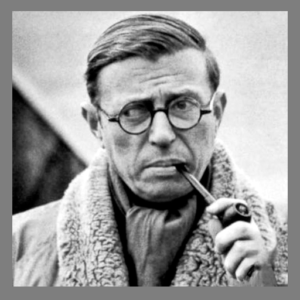
Avoiding nihilism and eternalism when studying and practicing the Middle Way [t = 1:52:59]
As Rinpoche often reminds us, there’s a potential pitfall here. And to be cautious for ourselves, we should not teach Madhyamaka to somebody who does not have a strong foundation, because then they might easily misunderstand the teachings as being teachings on nihilism. In other words they might misunderstand emptiness to mean the denial of self rather than realizing that ultimately the self is beyond the four extremes of existence, nonexistence, both and neither, and that relatively the self appears and functions like a magical illusion.
And as we saw last week, when these teachings were first translated into the West in the 19th and early 20th centuries, people misunderstood the Middle Way teachings as being a form of nihilism. They thought the teachings on non-self were actually saying nothing exists, which is of course not what we’re saying. But if you’re not really grounded in these teachings, if you don’t have enough of a practice of mindfulness and bodhicitta you may risk falling into some kind of depression when you hear there is no truth. There is no self. There is no ultimate purpose. Life is ultimately meaningless.
This is very much what happened with people who misunderstood existentialism. Because they concluded that there is no truth, there is no purpose to life, God is dead – many existentialists ended up as nihilists that didn’t just write about suicide but actually committed suicide. So it’s very important not to develop a nihilistic interpretation of emptiness.
And of course falling into the other extreme is also a risk. We might become eternalist. We might start taking excessive pride in our understanding. But that’s less likely, I think, although I should say that in the bhumi on discipline, in Chapter 2 verse 3 there’s a very nice quote that says if you’re dwelling on the purity of your own discipline, that is not pure discipline.
[2:3] Dwelling on the purity of his own discipline,
Is not pure discipline.
Thus in regard to its three [aspects], at all times
He is perfectly free of the engagements of dualistic mind.
If we start to develop a subject-object relationship with our discipline and we start to get attached to it, we’re not practicing nonduality any more. And as many of you I’m sure have read, Chögyam Trungpa Rinpoche talked and wrote about ‘spiritual materialism’, the idea that if we’re not careful, our Dharma path can just become an adornment to our ego. We can start to develop pride and get attached to our identity as a good practitioner, which then becomes another obstacle that we need to get rid of.
It’s certainly very important that we don’t become nihilistic with our path, and especially with these Middle Way teachings on emptiness, but it’s also important that we don’t become eternalistic. So just notice the temptation. Yes, if you’re the kind of practitioner that gets excited about these teachings and the hairs on your body quiver, that’s wonderful, but you don’t want to start to develop an identity around that. The identity that you want is as a bodhisattva, someone who is going beyond all of this. We might say that you are assuming a temporary identity of a person who is seeking to transcend all identities. As you recall from where we started this evening, the raft is for crossing over not for holding onto.
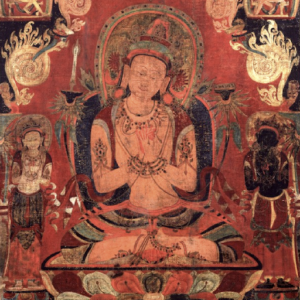
Practice [t = 1:55:53]
So with that we’ll close this week’s teaching, and I’ll leave you with some advice from Rinpoche. Chapter 6 verse 8 is where we start with all the logic and reasoning, and that’s really where the going becomes much tougher. If we use the Hero’s Journey analogy, that’s when we cross over the threshold out of the ordinary world and into this strange world of abstraction and logic, where we will be discussing the ultimate truth.
And because it’s considered a big threshold to cross, a big step, when this is taught traditionally in the shedras and monasteries, they do a big ceremony before they start verse 8. Rinpoche said that it would be auspicious for us to do something similar. So I encourage all of you between now and next week: please, whatever your practice is, do devote yourself to some practice specifically with the aspiration that you might understand these teachings and the rest of Chapter 6 that we’re about to embark upon, so that you might apply it and enlighten all sentient beings.
Many of you requested more practice materials on the website, so if you look on the Practice page you’ll see I’ve added some practices that you’re more than welcome to use. You can chant the Heart Sutra and the Mañjushri-Nama-Samgiti, and you’ll also find Jamyang Khyentse Wangpo’s instructions on how to practice the Mañjushri-Nama-Samgiti. But if you have some other practice, whatever your practice might be, I strongly encourage you to really accumulate some practice this week, to really accumulate some merit, so that next week we shall be ready to cross the threshold and embark upon our adventure. And with that, thank you very much. I wish you a wonderful week and I’ll see you next week.
[END OF WEEK 2]
[Week 3: Refuting wrong views: Introduction]
© Alex Li Trisoglio 2017
Transcribed and edited by Alex Li Trisoglio
Page last updated January 18. 2021